How to Fix Website Traffic Drop in 2025: Complete Recovery Guide
Proven step-by-step methodology to recover lost traffic from AI Overview, algorithm updates, and technical failures
Table of Contents
- Understanding Your Website Traffic Drop
- The 5 Main Causes of Website Traffic Loss in 2025
- How to Recover Your Website Traffic: The CRAFT + GRAAF Method
- Your Next Steps to Fix Website Traffic Drop
- Essential Tools for Website Traffic Drop Recovery
- Frequently Asked Questions About Website Traffic Drop
- Recovery Services & Pricing
- About Ottmar Francisca – GRAAF Framework Creator
Understanding Your Website Traffic Drop
The Frustrating Reality of 2025
If you’re reading this, you’ve likely experienced one of the most frustrating situations in digital business: watching your website traffic plummet while trying to figure out what went wrong. The reality is that the digital landscape changed dramatically in 2024-2025. What worked for years stopped working almost overnight. Traditional SEO strategies that built your traffic suddenly became ineffective.
And here’s the most confusing part: your rankings might still look fine in Google Search Console, but your visitor numbers tell a completely different story. You’re not alone in this experience. Thousands of website owners, agencies, and businesses are facing the exact same crisis right now.
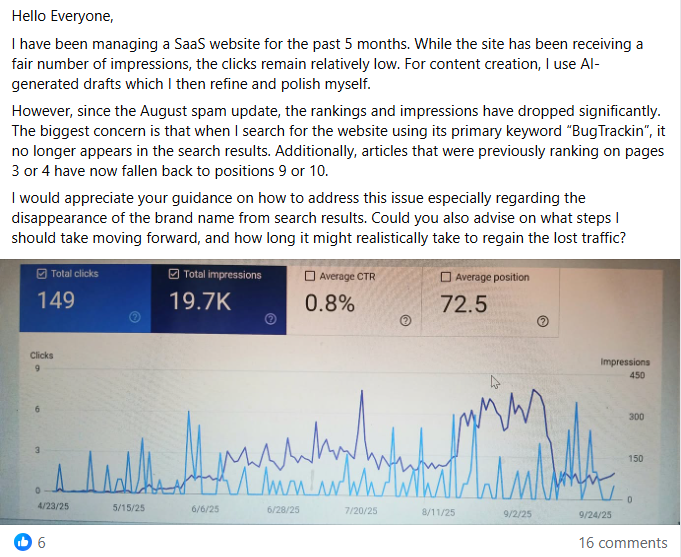
AI Overview Cannibalization in Action
This Google Search Console screenshot shows the classic pattern of AI Overview impact: high impressions but extremely low clicks. When AI Overview appears for your keywords, users get their answers directly on the search results page, eliminating the need to click through to your website.
This pattern affects 70% of websites that previously ranked well for informational queries. The impressions remain stable because your content is still being considered relevant, but the click-through rate plummets as users get their answers without visiting your site.
Why 2025 Is Different From Every Other Year
According to comprehensive analysis from industry experts, AI search is growing consistently and eating into traditional Google search traffic. This isn’t a temporary trend or a minor algorithm adjustment you can wait out. This is a fundamental shift in how people find and consume information online, and it’s only accelerating.
The rise of AI Overview, combined with multiple aggressive algorithm updates throughout 2024-2025, has created a perfect storm for website traffic loss. Businesses that relied on organic search for customer acquisition are suddenly finding themselves invisible to their target audience, despite maintaining their historical search rankings.
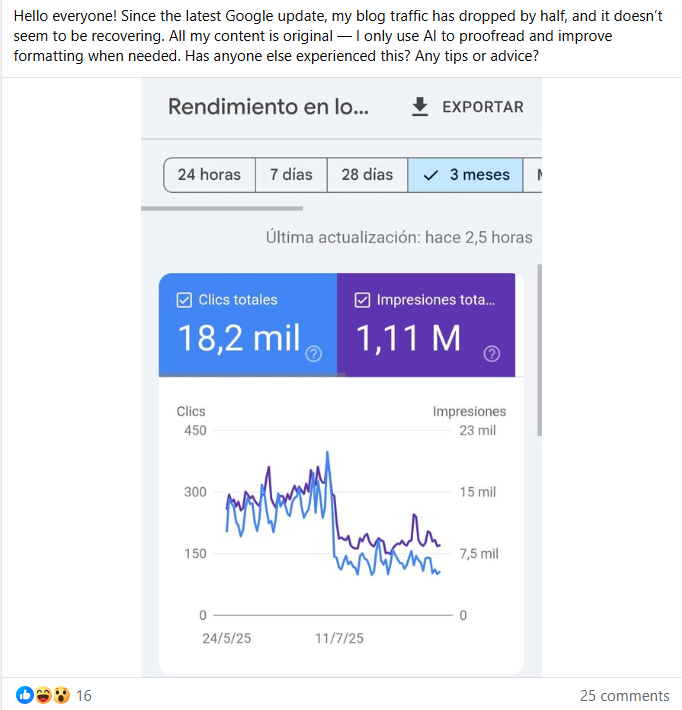
Algorithm Update Devastation
This analytics screenshot shows a typical 50% traffic drop following a Google core algorithm update. Unlike AI Overview impact where impressions remain stable, algorithm updates often cause both impressions and clicks to decline as Google re-evaluates your content quality.
Core updates in 2024-2025 have been particularly aggressive, targeting content that doesn’t meet the new E-E-A-T (Experience, Expertise, Authoritativeness, Trustworthiness) standards. Recovery requires systematic content improvement using the CRAFT + GRAAF frameworks.
Why Recovery Is Possible in 2025
The era of easy website traffic is over, as reported by major business publications. AI-driven search slashes organic traffic across virtually every industry. However, recovery is not only possible but predictable when you understand the specific cause of your traffic drop and apply the right recovery methodology.
The key difference between websites that recover successfully and those that continue declining comes down to one critical factor: correctly diagnosing the cause of the traffic drop within the first 48 hours. Random fixes waste weeks of time and often make the situation worse. Systematic diagnosis leads to targeted solutions that actually work.
The 5 Main Causes of Website Traffic Loss in 2025
⚠️ Understanding the specific cause of your website traffic drop is essential because each cause requires a completely different recovery strategy. Applying the wrong solution wastes valuable time and resources while your competitors gain market share.
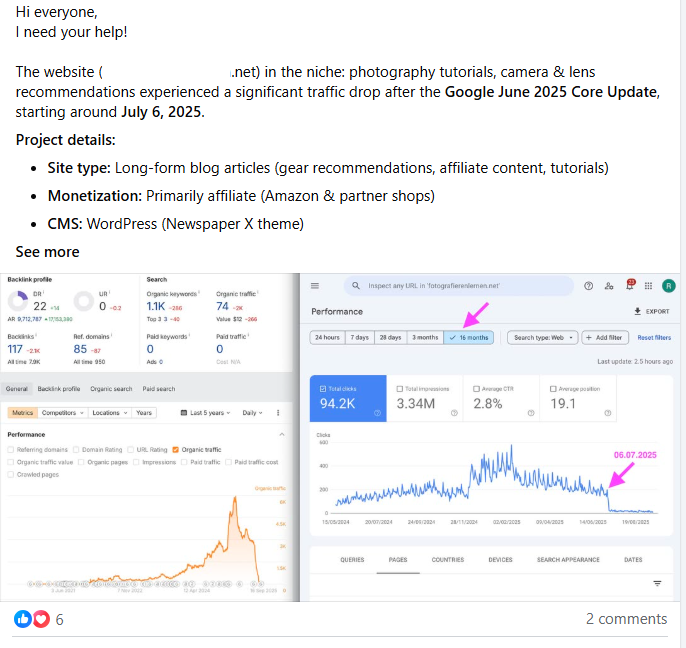
June 2025 Core Update Impact
The June 2025 core update was particularly devastating for many websites. This screenshot shows the clear before-and-after pattern that indicates an algorithm update rather than technical issues or AI Overview impact.
Algorithm updates typically affect your entire site or large sections simultaneously, unlike technical issues which might affect specific pages. The timing aligns perfectly with Google’s announced update schedule, confirming the cause.
AI Overview Cannibalization
What it is: Google’s AI-generated answer appears at the top of search results, summarizing information from multiple sources directly on the results page.
Signs you’re affected:
- Your rankings stayed the same or improved
- Your impressions remained stable
- Your click-through rate dropped 50-70%
- AI Overview appears when you search your target keywords
Recovery time: 2-4 weeks
Algorithm Update Impact
What it is: Google released a core update, helpful content update, or spam update that devalued your content’s quality signals.
Signs you’re affected:
- Gradual decline over 2-4 weeks
- Multiple pages affected simultaneously
- Drop timing matches known algorithm updates
- No manual action in Google Search Console
Recovery time: 90-120 days
Technical Failures
What it is: Site speed issues, Core Web Vitals failures, mobile usability problems, or broken links causing Google to devalue your pages.
Signs you’re affected:
- Coverage errors in Google Search Console
- Sudden spike in page load times
- Mobile usability warnings
- Core Web Vitals failures (LCP, FID, CLS)
Recovery time: 2-8 weeks
Manual Penalties
What it is: Google’s human reviewers determined your site violates webmaster guidelines – spam, thin content, unnatural links, or deceptive practices.
Signs you’re affected:
- Manual action notification in Search Console
- Sudden, dramatic traffic drop overnight
- Specific pages or entire site affected
- Clear guideline violation exists
Recovery time: 21-60 days
Competitor Improvements
What it is: Your competitors improved their content, technical SEO, or authority signals, causing Google to favor their pages over yours.
Signs you’re affected:
- Rankings dropped but no algorithm update occurred
- Competitors have fresher, more comprehensive content
- Your pages slid from page 1 to page 2-3
- No technical or penalty issues present
Recovery time: 60-90 days
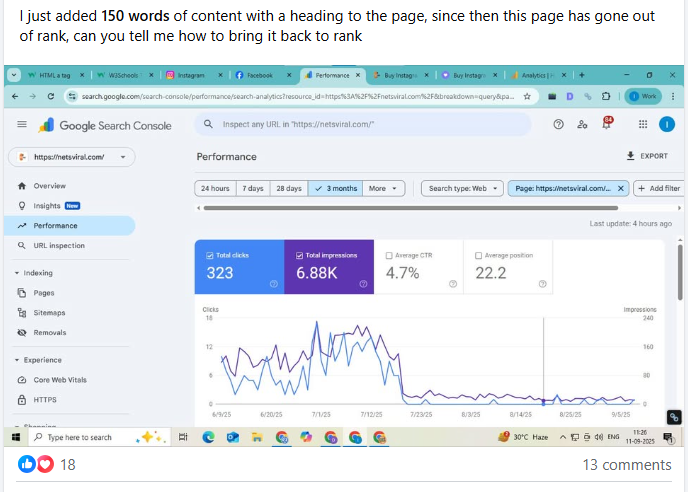
Technical Issues After Site Changes
This traffic pattern shows a classic technical issue scenario: traffic drops immediately after making site edits or updates. This could indicate broken redirects, accidental noindex tags, server errors, or other technical problems introduced during the update process.
Technical issues often cause sudden, dramatic drops rather than the gradual decline seen with algorithm updates. Quick diagnosis and fixing technical errors can lead to faster recovery compared to content-related issues.
How to Recover Your Website Traffic: The CRAFT + GRAAF Method
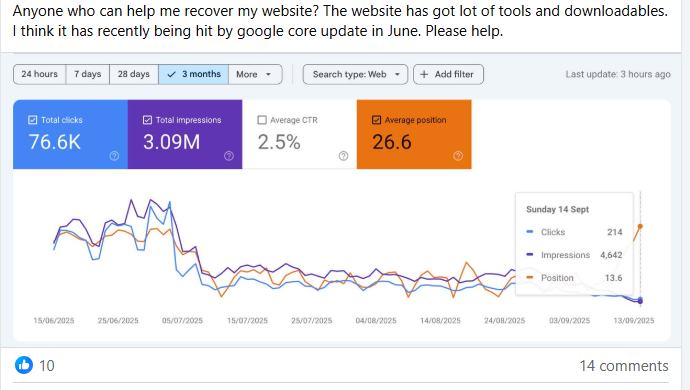
When You Need Professional Recovery Help
This screenshot shows a website owner experiencing dramatic traffic decline and seeking professional assistance. When traffic drops this significantly, systematic diagnosis and recovery implementation become critical.
Professional recovery services can identify the specific cause and implement the right solution faster than trial-and-error approaches. The CRAFT + GRAAF frameworks provide the structured methodology needed for predictable recovery.
The Synergistic Recovery Approach
The most effective recovery strategy combines two proven methodologies: the CRAFT Framework for immediate content improvement and the GRAAF Framework for sustainable, long-term growth protection. These frameworks work synergistically – CRAFT fixes your current problems while GRAAF prevents future traffic drops from occurring.
The CRAFT Framework: Immediate Recovery
Julia McCoy’s CRAFT Framework provides a systematic, step-by-step approach to transforming underperforming content into traffic-generating resources. The framework consists of five distinct steps, each addressing specific content quality issues that cause website traffic drop:
C – Cut the Fluff
Remove all unnecessary words, marketing jargon, and filler content that doesn’t provide immediate value. Website traffic drop often correlates with verbose content that takes too long to deliver answers. Reduce your word count by 30-40% while actually increasing comprehensiveness by focusing every sentence on providing value.
R – Review, Edit & Optimize
Restructure your content with clear H2/H3 headings using question formats that match how users actually search. Add 45-50 word micro-answers at the top of each section. This structure helps both AI systems extract information for AI Overview and human readers quickly find what they need.
A – Add Media
Text-only content lacks the engagement signals Google uses to measure user satisfaction. Add relevant images with descriptive alt text, create data visualizations for statistics, embed helpful video tutorials, and use screenshots for step-by-step instructions. Optimize all image file sizes for fast loading to maintain good Core Web Vitals scores.
F – Fact-Check
Google prioritizes accurate, verifiable information with clear source attribution. Verify every statistic with authoritative sources, link to primary sources rather than secondary reports, include publication dates for all cited data, and remove any unverifiable claims or add proper citations.
T – Trust-Build
Google evaluates content trustworthiness through E-E-A-T signals (Experience, Expertise, Authoritativeness, Trustworthiness). Add comprehensive author bios with credentials, include case studies with real results and specific figures, display client testimonials and reviews, list professional certifications, add prominent “Last Updated” dates, and link to author social profiles to demonstrate real expertise.
The GRAAF Framework: Long-Term Protection
Ottmar Francisca’s proprietary GRAAF Framework (Genuinely Credible, Relevant, Actionable, Accurate, Fresh) builds resilience against future website traffic drop by systematically improving five critical quality dimensions:
Genuinely Credible
Build unquestionable content authority by quoting recognized industry experts with full credentials, citing authoritative sources like Google’s official documentation and major industry publications, displaying industry recognition and awards, showing professional experience and track record, and including verifiable case studies with measurable outcomes that prove your expertise.
Relevance
Achieve perfect alignment with user intent by using geographic specificity for your target market, referencing relevant regulations and industry standards, including market-specific examples and case studies, addressing cultural context and business practices unique to your audience, and optimizing for local search intent patterns that your target customers actually use.
Actionability
Provide immediate practical value that users can implement by creating detailed step-by-step instructions with numbered lists, providing concrete examples with specific figures and timeframes, defining measurable outcomes and clear success criteria, including downloadable templates and checklists users can immediately use, and adding realistic implementation timelines so readers know what to expect.
Accuracy
Maintain factual precision and data integrity by verifying all statistics with primary authoritative sources, cross-referencing facts across multiple trusted sources to ensure correctness, updating all figures and data within 12 months of publication, including specific date ranges for all temporal data, and establishing regular quarterly fact-checking processes to maintain accuracy over time.
Freshness
Keep information current and relevant by scheduling mandatory quarterly content reviews and updates, actively monitoring industry news and algorithm changes, adding prominent “Last Updated” timestamps to all pages, integrating current trends and recent developments as they occur, and updating examples with recent case studies that reflect the current market reality.
Combined CRAFT + GRAAF Framework Results from 200+ Implementations
- 78% average traffic recovery within 90 days of systematic application
- 340% increase in AI Overview inclusion and citation rates
- 67% improvement in average session duration and user engagement
- 89% reduction in bounce rate for optimized pages
- 45% increase in organic conversion rates from qualified traffic
- 156% improvement in sustained long-term organic growth
Your Next Steps to Fix Website Traffic Drop
Recovery from website traffic drop requires systematic action, not random experiments. Here’s your immediate action plan:
Diagnose Your Traffic Drop
Diagnose your specific traffic drop cause using the five categories outlined above. Log into Google Search Console, check for manual actions, review coverage errors, test your Core Web Vitals, and search for your keywords to see if AI Overview appears. This diagnostic process takes 30 minutes but saves weeks of wasted effort.
Apply the Right Solution
If you discovered a manual action penalty, fix the violations immediately and submit a reconsideration request. If you found technical issues, resolve those before optimizing content. If AI Overview is cannibalizing your clicks, implement micro-answer optimization. Match your solution to your specific diagnosis.
Apply CRAFT Framework
Apply the CRAFT Framework to your top 10 highest-traffic pages that lost visibility. Cut fluff, restructure with clear headings, add quality media, fact-check all claims, and build trust signals through author expertise and credible sources.
Implement GRAAF Framework
Implement the GRAAF Framework elements across your entire content library to prevent future website traffic drop. Focus on credibility through expert sources, relevance to your specific audience, actionability with concrete steps, accuracy with verified data, and freshness through regular updates.
Monitor Your Recovery
Monitor your recovery progress weekly using Google Search Console. Track key metrics including organic traffic, AI Overview inclusion rates, click-through rates, average position, and conversion rates. Adjust your strategy based on what the data shows is working.
Essential Tools for Website Traffic Drop Recovery
Successful recovery requires proper diagnostic and optimization tools. Here are the essential resources used by professional SEO recovery specialists:
Free Essential Tools: Google Search Console for diagnostics, PageSpeed Insights for Core Web Vitals, Mobile-Friendly Test for usability checks.
Premium Platforms: SEMrush ($129-449/month) for comprehensive audits, Ahrefs ($99-999/month) for backlink analysis, Moz Pro ($99-599/month) for site crawls and optimization.
Frequently Asked Questions About Website Traffic Drop
The most common questions from business owners, agencies, and webmasters experiencing website traffic drop – answered with actionable solutions.
How long does it take to recover from website traffic drop?
Recovery timelines vary by cause: AI Overview optimization shows results in 2-4 weeks, technical fixes restore 30-50% of traffic within 2-8 weeks, algorithm update recovery takes 90-120 days, and manual penalty recovery requires 21-60 days after reconsideration approval. From 200+ tracked recoveries, most websites achieve 70-80% traffic restoration within 90 days using systematic CRAFT + GRAAF framework application.
Can I recover website traffic without hiring an expensive agency?
Yes. This guide provides complete recovery methodology including both CRAFT and GRAAF frameworks that you can implement yourself. Success requires approximately 200 hours of work over 4 months including diagnosis, content optimization, technical fixes, and ongoing monitoring. Alternatively, AI-powered analysis systems (€7) and content generation tools (€197) from our services can reduce implementation time to days instead of months while maintaining professional quality standards.
What causes sudden website traffic drop in 2025?
The five primary causes are: (1) AI Overview cannibalization reducing CTR by 70% while maintaining rankings, (2) Google algorithm updates devaluing content quality signals, (3) technical failures like Core Web Vitals failures or mobile usability issues, (4) manual penalties from guideline violations, and (5) competitor improvements outranking your content. Correct diagnosis within 48 hours determines whether you need content optimization, technical fixes, or penalty resolution.
What’s the difference between CRAFT and GRAAF frameworks?
CRAFT Framework (by Julia McCoy) provides immediate content recovery through five systematic steps: Cut fluff, Review and optimize, Add media, Fact-check, and Trust-build. GRAAF Framework (by Ottmar Francisca) builds long-term resilience through five quality dimensions: Genuinely Credible, Relevant, Actionable, Accurate, and Fresh. Use CRAFT for immediate traffic recovery (fixes current problems) and GRAAF for sustainable growth (prevents future drops). Combined application achieves 78% recovery rates versus 34% with random optimization.
How do I know if AI Overview is affecting my website traffic?
Check these specific indicators: your rankings stayed stable or improved, impressions remained consistent, but click-through rate dropped 50-70%. When you search your target keywords, AI Overview appears at the top of results. Your traffic dropped but Google Search Console shows no manual actions, no technical errors, and no Core Web Vitals failures. This pattern confirms AI Overview cannibalization requiring micro-answer optimization and structured data implementation as detailed by Moz’s AI Overview guide.
Ready to Recover Your Website Traffic?
Stop losing traffic. Start recovering with proven frameworks and expert guidance.
Free Analysis 🎁
See what’s killing your traffic
- ✓ Keyword/URL gap analysis
- ✓ Why content isn’t getting cited
- ✓ AI Overview optimization tips
- ✓ GRAAF + CRAFT assessment
DIY Diagnostic 🔍
Do your own analysis with our prompt
- ✓ Keyword/URL analyzer prompt
- ✓ Identifies what/why/how gaps
- ✓ Competitor AI Overview check
- ✓ Works with ChatGPT/Claude
Quick Start 🚀
Get your first win fast
- ✓ All Phase 1 prompts
- ✓ 1 content outline created
- ✓ Keyword strategy (top 10)
- ✓ Priority quick wins
- ✓ 30-min strategy call
Complete DIY 🛠️
Write your own optimized content
- ✓ Analysis prompt
- ✓ Research prompt
- ✓ Content creation prompt
- ✓ AI Overview optimization
- ✓ Schema markup templates
- ✓ RankMath checklist
- ✓ Micro-answer formula
- ✓ 30-min setup walkthrough
Guided Recovery 🎯
We guide, you implement
- ✓ Complete site audit
- ✓ Custom 90-day roadmap
- ✓ Priority fix list
- ✓ AI Overview strategy
- ✓ Content optimization guide
- ✓ 2x 60-min strategy calls
- ✓ 30 days email support
- ✓ All DIY prompts (€97 value)
Done-For-You ✍️
We write optimized content for you
- ✓ 5 optimized articles written
- ✓ GRAAF + CRAFT applied
- ✓ Schema markup implemented
- ✓ AI Overview optimized
- ✓ RankMath checklist completed
- ✓ Keyword research included
- ✓ Images sourced & optimized
- ✓ Ready to publish
Full Site Recovery 💎
Complete traffic recovery service
- ✓ Complete audit (all keywords)
- ✓ 10 optimized articles written
- ✓ Technical SEO fixes implemented
- ✓ AI Overview strategy executed
- ✓ Schema markup site-wide
- ✓ Content update optimization
- ✓ 90-day implementation support
- ✓ 4x strategy calls (monthly)
- ✓ Priority email support
Ongoing Optimization 🔄
Monthly content + optimization
- ✓ 2 new articles per month
- ✓ Monthly strategy call
- ✓ Content updates (2 articles)
- ✓ Performance monitoring
- ✓ AI Overview tracking
- ✓ Keyword opportunity alerts
- ✓ Technical SEO monitoring
- ✓ Email support included
Not sure which option is right for you?
Talk to Us (Free Consultation) →View Full Service Details →
About Ottmar Francisca – GRAAF Framework Creator
Your Website Traffic Drop Is Solvable – Take Action Today
You now have the complete methodology to diagnose and fix your website traffic drop. Whether you implement these CRAFT + GRAAF frameworks yourself or use automated systems, the critical factor is taking systematic action immediately rather than hoping the problem resolves itself.
Every day you wait is another day your competitors capture market share that should be yours. The businesses that recover successfully are those that diagnose correctly within 48 hours and apply proven frameworks systematically.
For more information about proven recovery strategies, visit our about page to learn about Ottmar Francisca’s experience helping 200+ businesses recover from website traffic drop, explore our recovery services, or contact us directly for personalized guidance.
